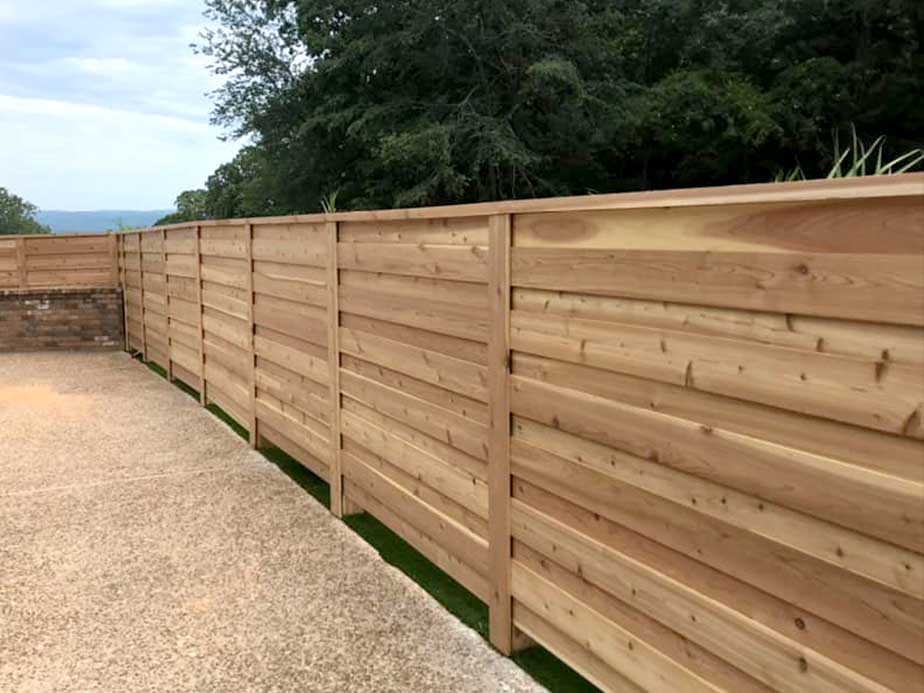All Categories
Featured
Setting up a fencing around your property can enhance personal privacy, safety and security, and aesthetics. Nevertheless, prior to beginning, it's necessary to determine whether you require an authorization for the installation. Various locations have differing laws, and recognizing what's required will assist ensure that your fencing is lawful, safe, and constructed according to local requirements. Right here's a guide to assist you navigate the allowing process for fence installation.
Why Are Permits Needed? Licenses are needed to make certain that the installment of your fence satisfies neighborhood structure codes and zoning laws. These laws are in place to preserve the safety and security, look, and functionality of buildings in your community. In addition, allows aid avoid disagreements with neighbors relating to building lines, fencing elevation, and various other architectural details.
Regional authorities need licenses to keep track of things like presence at junctions, public safety and security, and possible damage to utilities like pipes or electrical lines. The procedure aids maintain your fencing job certified with security and lawful requirements.
Kinds Of Authorizations You May Require. The specific permits required can differ depending upon your location and the specifics of your task. Below are one of the most typical kinds of permits you might require:
Structure Permit. Several cities and areas require a structure authorization for fencings that surpass a specific height, typically over 6 feet. This license makes sure that your fencing adheres to architectural criteria, especially if it's made from details products such as concrete, metal, or brick. Structure licenses are likewise required when your fencing influences the general landscape, like developing an audio barrier or obstructing a sightline.
Zoning Permit. Zoning permits are issued to make certain that your fence adheres to regional zoning legislations. These regulations might manage where fencings can be positioned on your home (e.g., side, yard, or front), exactly how high they can be, and whether they can be mounted near roads or walkways. Zoning legislations are established to maintain the total appearances of neighborhoods and maintain web traffic safety and security.
Trouble Permit. Some locations have obstacle laws that figure out how far a fence has to be from the property line, roadway, or certain public rooms. Setback licenses are developed to ensure that your fence doesn't hinder neighboring residential or commercial properties or public locations. A building study might be required to validate property lines before obtaining this sort of license.
HOA Approval. If you live in an area regulated by a Homeowners Organization (HOA), you might require to obtain approval from the HOA prior to setting up a fence. HOAs frequently have strict standards regarding the type of fencing allowed in the community, including its color, product, and elevation. Constantly contact the HOA before beginning your task to stay clear of any kind of disputes.
How to Apply for a Fence Permit. The process for acquiring an authorization normally includes several actions:
Study Citizen Rules. Beginning by inspecting your city or area's website to discover the specific demands for fencing setup. You may need to see the local planning or structure department face to face for even more thorough details.
Prepare Your Application. A lot of cities will call for an application form, that includes information concerning your planned fence, such as:
![]()
The kind of fence product (wood, vinyl, chain-link, and so on) The prepared elevation of the fencing. The area and measurements of the fencing. A residential or commercial property survey (to confirm property lines) Submit the Application. After finishing the application, submit it to the regional building or zoning office. You might be called for to pay a charge depending upon your place and the dimension of your fence. Charges can vary, however they usually cover the price of processing your request and assessing your strategies.
Await Authorization. As soon as your application is sent, the regional authorities will certainly evaluate your strategies to ensure they satisfy zoning and building demands. This procedure can take anywhere from a few days to a number of weeks, relying on the complexity of the job and the quantity of license demands in your location.
![]()
Assessment (If Essential) In some cases, you might need to set up an examination after the fence is set up to ensure it satisfies the required standards. Your local workplace will allow you understand if this action is essential.
When You Don't Required a Permit. Not every fence installation calls for a permit. Some situations where you may not need a license include:
Setting up a fence that's under a specific height (typically 3-4 feet for front lawns) Replacing an existing fencing with one that coincides height and material. Setting up a short-term fence (e.g., for building or horticulture) Nevertheless, even if your task appears tiny, it's always advisable to contact neighborhood authorities to make certain you're following the correct procedure.
Repercussions of Not Getting a License. Setting up a fencing without the essential authorization can result in substantial repercussions, including penalties, removal of the fence, and expensive reinstallation. In many cases, local authorities might require you to change the fencing if it doesn't fulfill code requirements. Furthermore, not acquiring a permit could produce disagreements with neighbors, especially if the fencing is put inaccurately or breaks regional elevation laws.
Final thought. Before mounting a fencing, it is necessary to look into the particular permitting needs in your location. Call your regional structure or zoning department to learn if a license is essential and to ensure that you're following the correct procedure. By safeguarding the right licenses, you'll avoid lawful issues and make sure that your fencing setup is risk-free, compliant, and easy.
Why Are Permits Needed? Licenses are needed to make certain that the installment of your fence satisfies neighborhood structure codes and zoning laws. These laws are in place to preserve the safety and security, look, and functionality of buildings in your community. In addition, allows aid avoid disagreements with neighbors relating to building lines, fencing elevation, and various other architectural details.
Regional authorities need licenses to keep track of things like presence at junctions, public safety and security, and possible damage to utilities like pipes or electrical lines. The procedure aids maintain your fencing job certified with security and lawful requirements.
Kinds Of Authorizations You May Require. The specific permits required can differ depending upon your location and the specifics of your task. Below are one of the most typical kinds of permits you might require:
Structure Permit. Several cities and areas require a structure authorization for fencings that surpass a specific height, typically over 6 feet. This license makes sure that your fencing adheres to architectural criteria, especially if it's made from details products such as concrete, metal, or brick. Structure licenses are likewise required when your fencing influences the general landscape, like developing an audio barrier or obstructing a sightline.
Zoning Permit. Zoning permits are issued to make certain that your fence adheres to regional zoning legislations. These regulations might manage where fencings can be positioned on your home (e.g., side, yard, or front), exactly how high they can be, and whether they can be mounted near roads or walkways. Zoning legislations are established to maintain the total appearances of neighborhoods and maintain web traffic safety and security.
Trouble Permit. Some locations have obstacle laws that figure out how far a fence has to be from the property line, roadway, or certain public rooms. Setback licenses are developed to ensure that your fence doesn't hinder neighboring residential or commercial properties or public locations. A building study might be required to validate property lines before obtaining this sort of license.
HOA Approval. If you live in an area regulated by a Homeowners Organization (HOA), you might require to obtain approval from the HOA prior to setting up a fence. HOAs frequently have strict standards regarding the type of fencing allowed in the community, including its color, product, and elevation. Constantly contact the HOA before beginning your task to stay clear of any kind of disputes.
How to Apply for a Fence Permit. The process for acquiring an authorization normally includes several actions:
Study Citizen Rules. Beginning by inspecting your city or area's website to discover the specific demands for fencing setup. You may need to see the local planning or structure department face to face for even more thorough details.
Prepare Your Application. A lot of cities will call for an application form, that includes information concerning your planned fence, such as:

The kind of fence product (wood, vinyl, chain-link, and so on) The prepared elevation of the fencing. The area and measurements of the fencing. A residential or commercial property survey (to confirm property lines) Submit the Application. After finishing the application, submit it to the regional building or zoning office. You might be called for to pay a charge depending upon your place and the dimension of your fence. Charges can vary, however they usually cover the price of processing your request and assessing your strategies.
Await Authorization. As soon as your application is sent, the regional authorities will certainly evaluate your strategies to ensure they satisfy zoning and building demands. This procedure can take anywhere from a few days to a number of weeks, relying on the complexity of the job and the quantity of license demands in your location.

Assessment (If Essential) In some cases, you might need to set up an examination after the fence is set up to ensure it satisfies the required standards. Your local workplace will allow you understand if this action is essential.
When You Don't Required a Permit. Not every fence installation calls for a permit. Some situations where you may not need a license include:
Setting up a fence that's under a specific height (typically 3-4 feet for front lawns) Replacing an existing fencing with one that coincides height and material. Setting up a short-term fence (e.g., for building or horticulture) Nevertheless, even if your task appears tiny, it's always advisable to contact neighborhood authorities to make certain you're following the correct procedure.
Repercussions of Not Getting a License. Setting up a fencing without the essential authorization can result in substantial repercussions, including penalties, removal of the fence, and expensive reinstallation. In many cases, local authorities might require you to change the fencing if it doesn't fulfill code requirements. Furthermore, not acquiring a permit could produce disagreements with neighbors, especially if the fencing is put inaccurately or breaks regional elevation laws.
Final thought. Before mounting a fencing, it is necessary to look into the particular permitting needs in your location. Call your regional structure or zoning department to learn if a license is essential and to ensure that you're following the correct procedure. By safeguarding the right licenses, you'll avoid lawful issues and make sure that your fencing setup is risk-free, compliant, and easy.
Latest Posts
Full Circle Strategic Marketing's Comprehensive Method to Industry Solutions
Published May 19, 25
1 min read
How to Know When Your Car Needs Professional Car Repair at Montclare Auto Repair
Published May 19, 25
1 min read
Dependable Business Roof Covering Services by Weathercraft
Published May 18, 25
1 min read
More
Latest Posts
Full Circle Strategic Marketing's Comprehensive Method to Industry Solutions
Published May 19, 25
1 min read
How to Know When Your Car Needs Professional Car Repair at Montclare Auto Repair
Published May 19, 25
1 min read
Dependable Business Roof Covering Services by Weathercraft
Published May 18, 25
1 min read